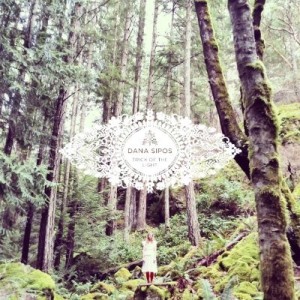 If like me you appreciate deeply rooted folk music that’s recorded with the sort of post-modern studio wizardry that enhances that music’s moods and meanings, then you owe it to yourself to check out Dana Sipos’ Trick of the Light.
If like me you appreciate deeply rooted folk music that’s recorded with the sort of post-modern studio wizardry that enhances that music’s moods and meanings, then you owe it to yourself to check out Dana Sipos’ Trick of the Light.
Sipos is Canadian, reared in industrial Hamilton, Ontario, but she’s spent a lot of time in the wilder regions of Canada and also in Appalachia, which is where most of the music on this album is rooted. And she has toured extensively in North America and Europe, sometimes by bicycle, tall ship, canoe and train.
Sipos recorded Trick of the Light in Toronto with musicians who are mostly based there, and most importantly with experimental producer and sonic wizard Sandro Perri. His production choices added to Sipos’ often-enigmatic lyrics are key to this album’s haunting, haunted mood. Perri’s penchant for drones and the shimmery textures of electronic music inform all of these songs. It’s a brilliant matchup of non-folk production with Sipos’s idiosyncratic and highly original songs.
The opener “Lean Times” is emblematic. “We’re all just hanging on for dear, dear life,” she sings in her mellow but emotive alto that’s been compared to Natalie Merchant’s. That’s as straightforward a lyric as you’ll find, and clearly spells out the song’s take on life in rural mountain America. But then, what does one of the next lines, “It’s raven in the morning, crow when you’ve got somewhere to be,” portend? From Sipos’ rhythmic, circular guitar fingerpicking and the sturdy folk melody, this is nothing if not an Appalachian song, but those wavering organ drones add a layer of mystery.
Likewise “Blue Ridge” and “Shenandoah,” song titles anchored firmly in Appalachia. The deeply twanging baritone guitar and high-lonesome fiddle line on “Blue Ridge” make this one of the most straightforward tracks on the album, as the sentiment of the lyrics makes plain her love of place. “I want to sing an old-time tune / I want to sing till the hills are singing too. / Though my body’s not from this place / though I’ve had Lord, but a taste / I long for the Blue Ridge.” The occasionally uneven meter of the verses echoes the music of the hollers as clearly as do the lyrics.
Before we get to “Shenandoah,” here’s the third track “Lighthouse Nights,” a deeply poetic love song of loneliness and blues. This is a live version recorded at Toronto’s Dream Date Studios, so you don’t get the effects of Perri’s production, but the mood is remarkably similar. I just love the juxtaposition of Sam Gleason’s shimmering guitar fills and Sipos’s alto vocals, lightly quavering.
The arc of the album runs from mostly straightforward folk songs – though presented with unconventional production – to the more avant garde, and then back again to relatively straight folk. So we move on to the shuffling train rhythm of “Do You Good,” with its jazzy guitar lead and droning bass, plus the doo-wop-informed backing chorus sounding like some kind of Nashville Cats from Space; and then the experimental dark folk of “Shenandoah.” This could be my favorite track of 2018 so far with its elements of avant garde from electronic keyboard drone, loosely tuned snare drum, and ghostly fiddles and guitars. Sipos’s vocals are low in the mix and deeply reverbed as she sings her about those mountains of Virginia: “You’ve been wandering, child, but don’t you wander far; I don’t, I don’t, I don’t have no home, but when Shenandoah calls, well you know I go.”
Then things really go off the rails with “Lily In The Window” and “When The Body Breaks.” “They say a storm be coming, batten down the hatches, baby,” Sipos intones on “Lily,” with Neko Case-like vocal stylings. It’s rather like a poetic recital over a beatnik coffee house accompaniment – a polyrhythmic arrangement of just a few elements: shakers, droning arco bass, electronica and horns, all seemingly playing a slightly different time signature. “When The Body Breaks” with outsider artist Mary Margaret O’Hara joining in on the vocals, at its root is a gospel song, but it’s full of yips and howls, random crashes and booms and shrieks from the horn section, and often no discernable rhythm at all.
After that it’s back toward the light with three more songs about the wind and the tides and the human heart, ending with a clearly Canadian, Lightfoot-like ballad “Fine Line” that feels like a homecoming with its fingerpicked acoustic and steel guitars.
I love a good, clean-cut folk song as much as anybody, and I don’t like studio frippery for its own sake. But sensitive yet innovative production can take solid indie-folk tunes and lyrics like Dana Sipos’s to a whole new level, highlighting the emotions and adding new layers of meaning, as it does on the 10 deeply affecting tracks of Trick of the Light. Sandro Perri does for Dana Sipos what fellow Canadian Daniel Lanois did for Emmylou Harris and Bob Dylan. Trick of the Light has a similar air of a breakthrough recording.
(Roaring Girl Records, 2018)
Learn more and listen to a couple of singles at her website.
